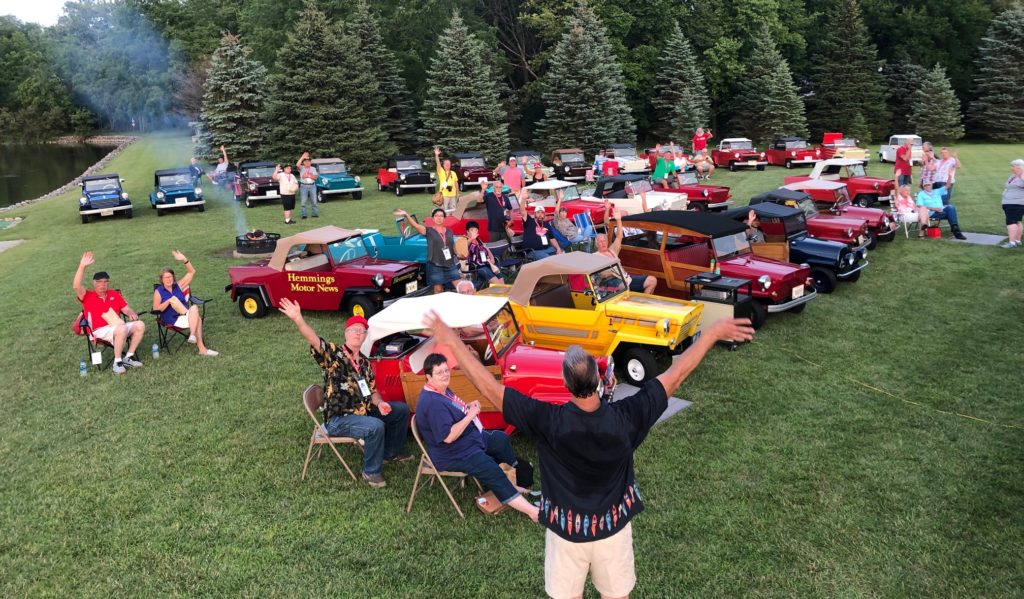By JAN LARSON McLAUGHLIN
BG Independent News
Lee Seats’ car had been used for target practice before he rescued it. Ken Frisch’s car had been used as a clown car – literally.
Like other King Midget Car owners, these men are crazy about their tiny cars that travel low to the ground and offer a cozy ride for two.
Local residents may have noticed an influx of the cars last week during the International King Midget Car Club’s 30th Annual Jamboree in Bowling Green and surrounding communities.
Eighty cars were registered for the annual gathering.
Just what is so loveable about these tiny cars with their ah-ooo-gah horns and convertible roofs?
“I guess they are quirky little cars – and it takes quirky people to drive them,” said Seats, the current president of the car club.
The micro-cars bring smiles to those they pass, said Seats, of Bristol, Tennessee.
“One thing about King Midgets, everyone sees these cars,” he said. “It’s like a one-car parade. It’s given me a truckload of friends.”
The jamboree, coordinated by Frisch, of Bowling Green, featured cars and owners from 19 states.

King Midgets were built in Athens, Ohio, from 1946 to 1970. It was advertised as the “World’s Number One Fun Car” and has a loyal following of enthusiastic car owners. The early cars had a 7.5hp motor, while later models were equipped with a larger 12hp motor. They averaged 50 to 70 miles per gallon and reached a top speed of 50 mph.
Many fans had to salvage their cars from scrap piles – or farm fields.
“Mine came out of a field in Kansas,” where it had been used for target practice, Seats said. “It had over 100 shot holes in it.”
But Seats wanted it nonetheless.
“Bolts were falling out of it as I drove it,” he said.
Seats remembered first setting his eyes on a King Midget in the pages of Popular Mechanics magazine. That was the beginning of his dream.
“Most people of my vintage and older wanted one as a kid,” Seats said.
One of Frisch’s microcars had a previous life as a clown car in parades. Frisch bought the car, which ended up sitting in his barn for about 20 years.
When he retired, he decided it was time to resurrect the King Midget.
“I took it completely down to the frame,” Frisch said. “It was in really rough shape – not road worthy.”
In fact, the person helping him with the renovations took one look at the King Midget and said, “Shouldn’t we just throw this away?”
But Frisch knew the treasure underneath all the rust. Plus, his motivation went beyond himself.
“Grandpa has to have something fun for the grandkids to do,” he said.
The annual jamborees are like family reunions, Seats said. It gives some owners an excuse to put down the roof and get out on the open road.
Seats has installed a bigger motor in his car, so he drives it quite a bit in Tennessee.
“I drive mine all the time,” he said, adding with a grin that his King Midget can break 85 mph. “I don’t drive it that fast much.”
Sharing the road with big trucks and SUVs can be a bit intimidating, he added.
“It’s a little unnerving.”
And sometimes, law enforcement officers are not sure what to make of the tiny cars on the roadways. Seats told of being pulled over in Bristol, Tennessee, by an officer unsure of the legality of the King Midget on the roadway. Seats heard another officer from Virginia on the radio.
“The Virginia guy said, ‘Hold him. I want to see it.’”

Both Frisch and Seats praised the genius of the founders of the Midget Motors Company – Claud Dry and Dale Orcutt.
The first years they built scooters before introducing their first car, a one seater. By 1951 they were building a two-seater and over the years many minor modifications were made including the introduction of a larger version of the two seater in 1957. In its heyday, the King Midget was the sixth largest selling car in America.
“You could drive them for a penny,” Seats said, making them an attractive second family car for average Americans.
Midget Motors started out as a surplus mail order business after World War II. The company first sold just the plans for the small cars, then graduated to selling the kit parts from its surplus directory.
Gradually the cars got bigger, to comfortably fit two people.
But there were still no “bells and whistles,” Frisch said. Doors and windshield wipers remained optional features.
“The vision these people had was so forward thinking,” Frisch said of Dry and Orcutt.
Their shrewd marketing included making customers wait for their orders.
“A big day for them was one car a day,” he said.
There are two basic groups of King Midget owners today, Frisch said. The purists want to leave the cars exactly as they were. And the modifiers want to change the cars to promote them and drive them more.
“They want to put their signature on it,” Frisch said.
In addition to spending time in Bowling Green, the jamboree participants went to Pemberville, Perrysburg, and a drive-in movie showing – of course – “Cars.”



